Dec 30, 2025
Dec 30, 2025
Global society has been bitten by the bug of climate change. Broadly it is a natural phenomenon. Climate change and natural hazards go hand in hand. It is well established that human interference exacerbates climate change and in turn natural hazards too. Human hand even otherwise frequently helps nature in augmenting the cause and impact of natural hazards. Thus climate change and natural hazards need to be viewed together and not in isolation. When we talk of a hazard, whether natural or anthropogenic it means a security risk for the human life. The adversary in this case could be climate and nature. One must know the adversary well before tackling him. Information about the past climates thus comes handy to predict the impacts of present climate upon the life on this planet.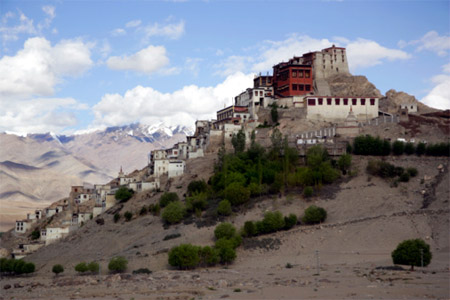
Thikse Monastery ' Ladakh
Landforms and rocks have some of the best records of the past climates. Tibetan plateau which continues to Ladakh and Karakoram has been considered to be the climate controller for the globe. Some workers even called it the pace-maker of climate change. Is it really so? We shall try to seek answer from the following narrative.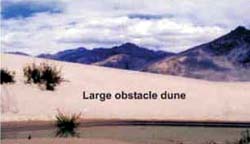 Ladakh and Karakoram ranges are a chest of information about the past. The British gazetteer of these ranges describes them as a 'rainless and cloudless' country. One has to trek through Ladakh to visualize and capture the beauty of this rocky desert. The colored, layered rocks in the background appear like a giant painting. The rarified atmosphere makes the sky look indigo blue and distances appear as if magically reduced and one can see unimaginably long distances. It is an illusion, in reality the peak which feels very close is infact far away.
Ladakh and Karakoram ranges are a chest of information about the past. The British gazetteer of these ranges describes them as a 'rainless and cloudless' country. One has to trek through Ladakh to visualize and capture the beauty of this rocky desert. The colored, layered rocks in the background appear like a giant painting. The rarified atmosphere makes the sky look indigo blue and distances appear as if magically reduced and one can see unimaginably long distances. It is an illusion, in reality the peak which feels very close is infact far away.
The rocks and landforms and their weathered products of Quaternary or the last chapter of the earth's history that started 1.75 million years ago have the maximum information on the climate change that affects all of us. Incidentally the Quaternary rocks are best exposed in Ladakh and Karakoram Himalayas. This area falls on the southwestern part of the Tibetan Plateau. This plateau is of great significance to the earth scientists because it holds the key to the dynamic relationship (not political!) between the Indian and the Asian Plate.
Fascinated and motivated by this fact Dr. R.K. Pant, Scientists Emeritus at Wadia Institute Of Himalayan Geology (WIGH), Dehradun and an expert on paleoclimates of glaciated terrains; N.R. Phadtare of WIGH, L.S. Chamyal of Geology Department, MS University of Baroda and Navin Juyal of Physical Research Institute (PRL), Ahmedabad, joined hand and took extensive traverses across this inhospitable terrain and collected valuable information on the past climates that the region had witnessed. Their findings were published in June 2005 issue of theCurrent Science.
The uplift of the Himalayas and Tibet has been exerting a profound influence on the climate since past ages. It is because of Tibetan plateau the surface westerly winds are split in to northern and southern branches and the plateau also prevents the freezing of the Indian subcontinent by stopping southward flow of the cold continental air. Similarly, the Tibetan Plateau acts like a thermostat by providing the required thermal gradient during summers to drive the South Asian monsoon. The Himalayan uplift has resulted into more weathering and erosion, which in turn means consumption of more carbon dioxide. Question is whether the uplift and climate change are coupled processes or one leads to other.
Maureen Raymo of Boston University along with Flip Froelich and Bill Ruddiman published a series of papers in 1988 giving a hypothesis that the late Cenozoic that is around two million years ago the cooling of climate or the Ice Age, was caused by enhanced chemical weathering and consumption of atmospheric CO2 in the mountainous regions of the world, in particular the Himalayas. The collision of the Indian Plate with the Asian Plate some 40 to 50 million years ago led to the uplift of the Himalayas including the formation of Tibetan Plateau. The creation of the plateau intensified the Asian monsoon and large rainfall plus the steep relief of the mountains caused the highest chemical weathering rates observed for any region.
It is this chemical weathering that consumed the atmospheric CO2 and weekend the 'greenhouse' effect, caused global cooling and led to formation of giant ice sheets spreading from the poles. Whether this was a mere conjecture or result of some concrete evidence is a matter of debate. In order to bring out a concrete picture of the past landscape and climate during the Quaternary period Pant and his colleagues trekked right across Ladakh and parts of Karakoram along some of the torturous valleys and difficult, snow-bound mountain passes.
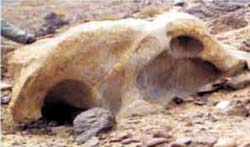 The region of ladakh and Karakoram falls in the rain shadow of Indian summer monsoon. The shadow is so powerful that Karakoram landscape is entirely arid to semi-arid. Several landforms like sand dunes and 'deflation hollows' typical of erosion by cold dry winds bear testimony to the cold desert. The winter rains derived from the westerly derived disturbances are the only source of precipitation during winter. This falls in the form of snow. The region as such remains dry because of north and northeast winds from barren desert of Takla Makan and Aksai Chin in western Tibet.
The region of ladakh and Karakoram falls in the rain shadow of Indian summer monsoon. The shadow is so powerful that Karakoram landscape is entirely arid to semi-arid. Several landforms like sand dunes and 'deflation hollows' typical of erosion by cold dry winds bear testimony to the cold desert. The winter rains derived from the westerly derived disturbances are the only source of precipitation during winter. This falls in the form of snow. The region as such remains dry because of north and northeast winds from barren desert of Takla Makan and Aksai Chin in western Tibet.
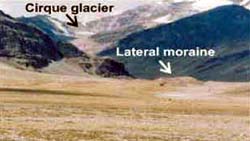 Taking the cue from 'present is a key to the past' it is seen that the landscape above 3000 m altitude has been carved by glacial activity. 'U' shaped valleys speak loudly about their glacial origin. Around 3000 m altitude the valleys have marks of water activity. In other words it means that this generally arid landscape does have enough moisture for water to re-carve parts of it. When the nature is at work, a landscape is not created overnight. It is the effort of various erosional and denudational agencies for years together. The rates of denudation in the upper Indus and Hunza valley vary between 1 and 5-6 mm/year respectively. The denuded sediments are carried by various agencies. For example when they are carried by glaciers they acquire particular characters and are deposited as glacial sediments. Likewise they could be fluvial-carried and deposited by rivers or Aeolian-carried and deposited by winds etc.
Taking the cue from 'present is a key to the past' it is seen that the landscape above 3000 m altitude has been carved by glacial activity. 'U' shaped valleys speak loudly about their glacial origin. Around 3000 m altitude the valleys have marks of water activity. In other words it means that this generally arid landscape does have enough moisture for water to re-carve parts of it. When the nature is at work, a landscape is not created overnight. It is the effort of various erosional and denudational agencies for years together. The rates of denudation in the upper Indus and Hunza valley vary between 1 and 5-6 mm/year respectively. The denuded sediments are carried by various agencies. For example when they are carried by glaciers they acquire particular characters and are deposited as glacial sediments. Likewise they could be fluvial-carried and deposited by rivers or Aeolian-carried and deposited by winds etc.
Confused by the volume of sediments carried and deposited by different natural agencies the earlier workers believed that four glacial episodes had taken place in Ladakh and Karakoram. In other words there were four periods of cooling within the past 1.75 million years. However, work carried by E. Derbyshire and his colleagues, using thermo-luminescence and radio-carbon dating methods has proved only three glacial episodes.
There is a strong reason for this contradiction. The Himalayas are the greatest mountain range on the earth, stretching for over 2000 km from Burma to Afghanistan. The central and eastern part of the range is affected by the monsoonal climate of South Asia. Whereas the more westerly parts that is Hindu-Kush and Karakoram are beyond the influence of this monsoon system. They derive their precipitation from the winter monsoons. Thus, Himalayan glaciers are expected to exhibit asynchronous responses to climate change, depending on sensitivity to temperature fluctuations and their location with respect to shifting moisture sources. With the development of techniques of Optically Stimulated Luminescence and Cosmogenic Exposure Dating absolute dating of moraines has become possible and a clearer picture is emerging.
The study carried by Pant and his colleague has clearly demonstrated that Ladakh and Karakoram area was extensively glaciated during the Quaternary Period. The presence of 'U' shaped valleys and extensive glaciogene sediments along the upper course of major rivers speak aloud of their origin. The material carried and deposited by the glaciers on their flanks is known as lateral moraine. Such moraines are well preserved at many places like Bara Lacha La and Shyok and Nubra River valleys.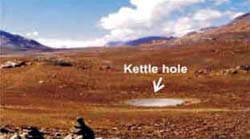 Receding glaciers have left behind tell tale marks as 'Kettle Holes' on the valley floors. They are created by blocks of ice dislodged from a retreating glacier and buried in the outwash plain. Later the ice melts and holes remain as remnants. The evidences coming forth indicate that this region experienced at least two glacial advances in the Quaternary Period.
Receding glaciers have left behind tell tale marks as 'Kettle Holes' on the valley floors. They are created by blocks of ice dislodged from a retreating glacier and buried in the outwash plain. Later the ice melts and holes remain as remnants. The evidences coming forth indicate that this region experienced at least two glacial advances in the Quaternary Period.
A. Zhisheng of Chinese Academy of Sciences and his colleagues have used wind born sediments from China and marine sediments from the Indian and north Pacific oceans. Based on these they have identified three stages of evolution of Asian climates: first enhanced aridity in the Asian interior and onset of Indian and east Asian monsoons about 9-8 million years ago; next, continued intensification of the east Asian summer and winter monsoons, together with increased dust transport to the North Pacific Ocean, about 3.6-2.6 million years ago; and last, increased variability and possible weakening of the Indian and east Asian summer monsoons and continued strengthening of the east Asian winter monsoon since about 2.6 million years ago. The results of a numerical climate-model experiment, using idealized stepwise increases of mountain-plateau elevation, support the argument that the stages in evolution of Asian monsoons are linked to phases of Himalaya-Tibetan plateau uplift and to Northern Hemisphere glaciations.
It appears that had the Himalayas not been there, we would have perhaps perished long back, due to extreme droughts. It also appears that there is a relationship between the rise of the Himalayas and the climate. The rise is also linked with the dynamic crust underneath, which in turn is also responsible for natural disasters like earthquakes. Thus in totality the nature's forces are all interconnected and we should not try to underestimate them. The recent developments in science and technology need to be fully utilized in understanding the nature's ways to help the world know what the nature has in store for us.
07-Jul-2007
More by : V. K. Joshi (Bijji)